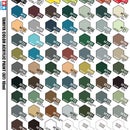Introduction: Desoldering Complex Components
Have you ever wanted to get that random chip or component off that random circuit board you've got?
Sure that's easy to do with things like capacitors or LED's, but when it comes to more complex things it gets a bit harder... And when things get tough - Use a BLOW TORCH!
Supplies
1). Outside space
2). Blow torch
3). Pliers with any rubber handles removed
4). Heat Gloves
5). Heat proof mat (soldering mat)
Step 1: Survey the Board
If you've already pinpointed what you want to salvage from the board, this step isn't important for you, BUT there are other things you need to look out for, so if you're not wanting to set the board on fire then read this bit.
For motherboards, look out for any black stickers or glue residue, like the stuff seen above in the picture. Also look for any permanent marker lines, because these go up in flames and they stink. Last, try not to target any components that are very close to or are made of plastic with metal contacts, because again these will burn instantly and the smoke produced is poisonous.
Other than safety, find the components you want to remove and remember the corresponding pins on the other side of the board to make it easier.
Step 2: Get Ready!
Get a nice, tough long-sleeved shirt on, grab your gear and head on outside to a flat, not flammable area!
Slip on those heat gloves and sure any rubber handle grips on the pliers are detached so they don't melt as well.
I you've got any clay or stone bricks, these help to prop up the circuit board as well as creating a fire-proof surface.
Step 3: Start Meltin'
Just before you start burning things, Practice Makes Perfect, so if you can, practice this technique before removing your components on something less important, that you don't intend to keep, for example a capacitor (this is also easier as it only has two wires.)
-- BEFORE --
1). Setting - Make sure the air intake on your blowtorch is set to fully open or, if there isn't one, make sure you don't cover it with your fingers.
2). Distance - The distance between the end of the blow torch and the opposite side of the board to the component should be about 3cm or 1" away from the surface.
3). Position - You need to be able to have the board held, hold the blowtorch and be able to pull with enough force to remove the component from the molten solder. Also make sure your holding the pliers with the gloved hand, not the blowtorch.
-- START --
1). Fire up the torch and set it to about half gas output.
2). Start heating the solder blobs holding the contacts/metal of the needed component slowly, making sure to spread heat across all the solder points by moving the flame in a circular motion.
3). You'll be noticing that the solder blobs are melting and you may get some stray sparks. this is any air or rosin that is in the solder, reaching the surface of the solder and igniting for a less than a second.
4). At this stage you're going to want to start trying to grip the component with the pliers and what you need to do is gently pull on it on one side, and then on the other, wiggling it left and right while still keeping the heat on the solder.
Step 4: POP!
POP! After a bit of this the component should come away clean and mostly free of solder!
Yay!
?











